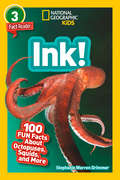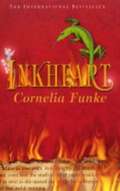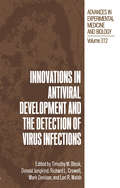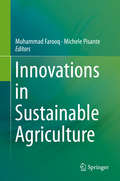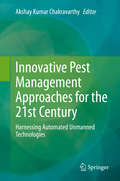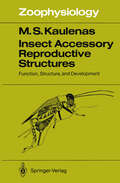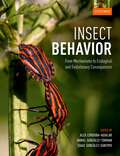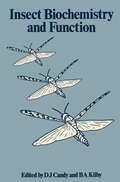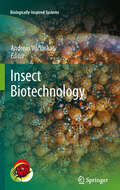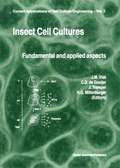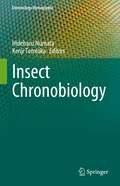- Table View
- List View
Inhibitory Synaptic Plasticity
by Melanie A. Woodin and Arianna MaffeiThis volume will explore the most recent findings on cellular mechanisms of inhibitory plasticity and its functional role in shaping neuronal circuits, their rewiring in response to experience, drug addiction and in neuropathology. Inhibitory Synaptic Plasticity will be of particular interest to neuroscientists and neurophysiologists.
Ink!: 100 Fun Facts About Octopuses, Squid, And More (National Geographic Readers)
by National Geographic Kids Stephanie Warren DrimmerMeet cuttlefish that can camouflage themselves, octopuses that outsmart their predators, and squids that patrol the deep in this cool fact-filled reader.
Inkheart
by Cornelia FunkeWhen Meggie's life is shattered by Dustfinger, a mysterious stranger, she follows him into a vivid world of stories where danger lurks at every turn...
Inland Waters of Southern Africa: An Ecological Perspective (Monographiae Biologicae #64)
by B.R. Allanson R.C. Hart J.H. O'Keeffe R.D. RobartsLimnology - the study of inland waters - had its genesis in Europe about the turn of the century. The studies of Fore1 on Lake Geneva were of seminal value at this time. It prospered under the early guidance of Thienemann, Naumann and Wesenberg-Lund in Europe and, soon transplanted, of Birge and Juday in North America (to name just a few early spirits). Now, liminology is a respectable scientific discipline taught at many universities, and limnologists are recognized as important contributors to our understanding of how this fragile spaceship functions. All this acknowledged, it must also be acknowledged that limnology is not yet a globally comprehensive science. To be sure, much is known about globally applicable processes, and the structural elements of aquatic ecosystems worldwide, but limnological emphases, interests and concerns remain essentially European and North American in balance. Much is known about lakes and rivers in less than one fifth of the world's land area (northern temperature regions); rather little is known about inland waters elsewhere.
Innate Tolerance in the CNS: Translational Neuroprotection by Pre- and Post-Conditioning (Springer Series in Translational Stroke Research)
by Jeffrey M. Gidday, Miguel A. Perez-Pinzon and John H. ZhangCerebral preconditioning is a phenomenon wherein a mild insult or stress induces cellular and tissue adaptation or tolerance to a later, severe injury, therefore reflecting the efficacy of endogenous mechanisms of cerebrovascular protection. Initially identified for rapid cardiac protection, preconditioning has expanded to all aspects of CNS protection from ischemia, trauma and potentially neurodegeneration. Many different stimuli or stressors have been identified as preconditioning agents, suggesting a downstream convergence of mechanisms and underscoring the potential for translational application of preconditioning in the clinic. Moreover, the fundamental mechanisms responsible for preconditioning-induced tolerance will help in the design novel pharmacological approaches for neuroprotection. While stroke and many other brain injuries are not predictable, in some populations (e.g., metabolic syndrome, patients undergoing carotid endarterectomy, aneurysm clipping, or with recent TIAs) the risk for stroke is identifiable and significant, and preconditioning may represent a useful strategy for neuroprotection. For unpredictable injuries, post-conditioning the brain – or inducing endogenous protective mechanisms after the initial injury – can also abrogate the extent of injury. Finally, remote pre- and post-conditioning methods have been developed in animals, and are now being tested in clinical trials, wherein a brief, noninjurious stress to a noncerebral tissue (i.e., skeletal muscle) can provide protection to the CNS and thereby allows clinicians the opportunity to circumvent concerns regarding the direct preconditioning of neurological tissues.
The Inner Life of Animals: Surprising Observations of a Hidden World (Everyman's Library CLASSICS)
by Peter WohllebenCan horses feel shame? Do deer grieve? Why do roosters deceive hens? We tend to assume that we are the only living things able to experience feelings but have you ever wondered what’s going on in an animal’s head? From the leafy forest floor to the inside of a bee hive, The Inner Life of Animals opens up the animal kingdom like never before. We hear the stories of a grateful humpback whale, of a hedgehog who has nightmares, and of a magpie who commits adultery; we meet bees that plan for the future, pigs who learn their own names and crows that go tobogganing for fun. And at last we find out why wasps exist.
The Inner Life of Cats: The Science and Secrets of Our Mysterious Feline Companions
by Thomas McNameeOur feline companions are much-loved but often mysterious. In The Inner Life of Cats, Thomas McNamee blends scientific reportage with engaging, illustrative anecdotes about his own beloved cat, Augusta, to explore and illuminate the secrets and enigmas of her kind. As it begins, The Inner Life of Cats follows the development of the young Augusta while simultaneously explaining the basics of a kitten's physiological and psychological development. As the narrative progresses, McNamee also charts cats' evolution, explores a feral cat colony in Rome, tells the story of Augusta's life and adventures, and consults with behavioral experts, animal activists, and researchers, who will help readers more fully understand cats. McNamee shows that with deeper knowledge of cats' developmental phases and individual idiosyncrasies, we can do a better job of guiding cats' maturation and improving the quality of their lives. Readers' relationships with their feline friends will be happier and more harmonious because of this book.
Innovations in Antiviral Development and the Detection of Virus Infections (Advances in Experimental Medicine and Biology #312)
by Timothy Block Richard Crowell Mark Dennison Donald L. Jungkind Lori R. WalshTHE ERA OF ANTIVIRALS Introduction Although there are more than one hundred medically useful antibiotics and fungicides, there are only seven compounds licensed for use as antiviral agents, in the USA. Some of these (acyclovir and ganciclovir) are actually derivatives of each other, making the number of new discoveries even smaller. Moreover, most of these agents are of only limited therapeutic value and have substantial toxicity. It has been more than 100 years ago since Pasteur studied rabies virus (2) and Rous (4) showed that a small filterable agent (not bacteria) caused disease (sarcoma) in chickens. It was nearly 100 years ago that yellow fever virus, the first recognized human pathogenic virus, was unambiguously associated with disease (3). Enteroviruses were cultured for the first time nearly 50 years ago (1). Why then has effective chemotherapy against viruses lagged behind that of other microorganisms? Viruses are often difficult to grow and image. However, with the dynamic advances in molecular biology and increased sophistication in tissue culture, the field of virology has blossomed and resulted in improved methods for detection of virus infection. The use of viruses as models of gene regulation and replication has also resulted in a massive accumulation of information.
Innovations in Sustainable Agriculture
by Muhammad Farooq Michele PisanteThis volume is a ready reference on sustainable agriculture and reinforce the understanding for its utilization to develop environmentally sustainable and profitable food production systems. It describes ecological sustainability of farming systems, present innovations for improving efficiency in the use of resources for sustainable agriculture and propose technological options and new areas of research in this very important area of agriculture.
Innovative Pest Management Approaches for the 21st Century: Harnessing Automated Unmanned Technologies
by Akshay Kumar ChakravarthySeveral Integrated Pest Management (IPM) approaches are available for managing pests of varied kinds, including individual and integrated methods for pest suppression. Recently the focus has shifted to pest management tools that act on insect systems selectively, are compatible with the environment, and are not harmful for ecosystems. Other approaches target specific biochemical and physiological aspects of insect metabolism, and involve biotechnological and genetic manipulation. Still other approaches include the use of nanotechnology, endophytes, optical and sonic manipulation to detect and control pest insects. Unfortunately, conventional forms of pest management do not focus on technology transfer to the ground level workers and farmers. As a result, farmers are incurring huge losses of crops and revenues. This book highlights the importance of using communication tools in pest management and demonstrates some success stories of utilizing automated unmanned technologies in this context. The content is divided into three sections, the first of which, “Pest Population Monitoring: Modern Tools,” covers long and short-range pest population monitoring techniques and tools such as satellites, unmanned aerial vehicles/drones, remote sensing, digital tools like GIS, GPS for mapping, lidar, mobile apps, software systems, artificial diet designs and functional diversity of info-chemicals. The second section of the book is devoted to “Emerging Areas in Pest Management” and offers a glimpse of diversified tactics that have been developed to contain and suppress pest populations such as endophytes, insect vectors of phytoplasma, Hymenopterans parasitoids, mass production and utilization of NPV etc. In turn, the third section focuses on “Integrated Pest Management” and presents farming situations that illustrate how research in diversified aspects has helped to find solutions to specific pest problems, and how some new and evolving tactics can be practically implemented. Given its scope, the book offers a valuable asset for entomology and plant pathology researchers, students of zoology and plant protection, and readers whose work involves agriculture, horticulture, forestry and other ecosystems.
Innoveren in houdbare zorg is topsport
by Robbert Huijsmanhet boek bevat een slectie van weblogs van de hand van Robbert Huijsman over het anders en slimmer organiseren van de zorg. Eerder gepubliceerd op Skipr.nl in periode 2009-2013.
Insect Accessory Reproductive Structures: Function, Structure, and Development (Zoophysiology #31)
by M.S. KaulenasIn retrospect, the range of topics covered in this monograph, although forming a coherent ensemble, is so extensive that a detailed discussion could easily extend to three or four times the current length. My approach has been to identify the critical issues, summarize the major accomplishments, and to suggest promising avenues for future research. To facilitate this sum mary presentation, I have limited the literature review largely to material published after 1970, extending to material appearing late in 1990. I gratefully acknowledge the advice of many colleagues, particularly the valuable criticisms of Drs. Warren Burggren, Joseph Kunkel, Randall Phillis, and John Stoffolano. I also wish to thank Mrs. Elizabeth Brooks for secretarial assistance. Finally, thanks are due to Dr. D. Czeschlik and his staff at Springer Verlag for their patience and support. Amherst, MA, October 1991 M. S. KAULENAS V Contents Chapter 1 Introduction . . . . . . . . . . . . . . . . . . . . . . . . . . . 1 Chapter 2 The Reproductive Elferent Duct Systems and Associated Structures. Development and Genetic Control of Differentiation . . . . . . . . . . . . . . . . . . . . . . . . . 5 2. 1 Origin of the Germ Cells and Associated Cells and Tissues . . . . . . . . . . . . . . . . . . . . . . . . . . . . . . . . 5 2. 2 Differentiation of the Efferent Duct System and Associated Structures . . . . . . . . . . . . . . . . . . . 9 2. 2. 1 The Male System . . . . . . . . . . . . . . . . . . . . . . . . . . . 9 2. 2. 2 The Female System . . . . . . . . . . . . . . . . . . . . . . . . . 13 2. 3 Genetic Control of Sexual Differentiation . . . . . 16 2. 3. 1 Daughterless. . . . . . . . . . . . . . . . . . . . . . . . . . . . . . . 17 2. 3. 2 Sex Determination: Measurement of the X:A Ratio. . . . . . . . . . . . . . . . . . . . . . . . . . 20 2. 3. 3 Sex Lethal . . . . . . . . . . . . . . . . . . . . . . . . . . . . . . . . . 22 2. 3. 4 Genes Controlling Somatic Sexual Differentiation . . . . . . . . . . . . . . . . . . . . . . . . . . . . . 24 2. 3. 5 Dosage Compensation . . . . . . . . . . . . . . . . . . . . . .
Insect Aging: Strategies and Mechanisms
by Klaus-Günter Collatz Rajindar S. Sohal"Leben ist die schonste Erfindung der Natur und der Tod ist ihr Kunstgriff, viel Leben zu haben" . J. W. v. Goethe Life is the most beautiful invention of nature, and death is her device to exhibit most life. The eminent British biologist Sir Vincent B. Wigglesworth noted in 1939 that insects are an ideal medium in which to study all problems of physiology. Many fundamental discoveries in biology, particularly genetics and development, have been made on the basis of studies conducted in insects. Because of their ex treme adaptability and diversity, an appropriate insect model is available for the study of virtually any biological problems. The applicability to other groups, including mammals, of basic studies conducted on insects has helped in the gradual acceptance of the fundamental unity of biochemical principles as a dogma among biologists, as well as among enlightened medical scientists. With the recent upsurge of interest in the study of the aging process, in sects have been increasingly employed not only for the investigation of basic mechanisms of aging, but also to gain insight into the evolution of aging and senescence. If only one aging mechanism exists, it is foreseeable that some in sects, especially Drosophila, will help to unravel its molecular basis. Because of their diversity, existing studies in the gerontology of insects are widely scat tered in various specialized journals. This wealth of existing information has not, as yet, been brought together in a synthesized and comprehensive form.
Insect Behavior: A Sourcebook Of Laboratory And Field Exercises
by Robert W. Matthews Janice R. MatthewsThis book offers a comprehensive overview of fundamental concepts of animal behavior as they relate to insects. Considerably updated and expanded, this new edition includes 26 case studies, as well as 45 new color plates and 173 figures (over 40% of them new) with detailed legends that add richness to the well-written, accessible text.
Insect Behavior: From Mechanisms to Ecological and Evolutionary Consequences
Insects display a staggering diversity of behaviors. Studying these systems provides insights into a wide range of ecological, evolutionary, and behavioral questions including the genetics of behavior, phenotypic plasticity, chemical communication, and the evolution of life-history traits. This accessible text offers a new approach that provides the reader with the necessary theoretical and conceptual foundations, at different hierarchical levels, to understand insect behavior. The book is divided into three main sections: mechanisms, ecological and evolutionary consequences, and applied issues. The final section places the preceding chapters within a framework of current threats to human survival - climate change, disease, and food security - before providing suggestions and insights as to how we can utilize an understanding of insect behavior to control and/or ameliorate them. Each chapter provides a concise, authoritative review of the conceptual, theoretical, and methodological foundations of each topic.
Insect Biochemistry and Function
by David John Candy B. A. KilbyThere has been a considerable upsurge in interest in insect bio chemistry and physiology in recent years and this has been reflected in a notable expansion in the number of original papers in this field. Whereas insect physiology has tended to receive ample attention from reviewers, the same has not always been true for the more of insect research. This book is a venture to help biochemical aspects redress the balance. No attempt has been made to cover all aspects of insect biochemistry, but rather a few topics have been selected which seemed to us to merit a review at the present time. One reason for this increased interest in insect biochemistry is perhaps the growing realization that insects can be very useful organisms to act as model systems for the experimental study of general biochemical principles. One remembers, for instance, that Keilin's perceptive observations on the flight muscles of living bees and wax moths led to his discovery of the cytochromes. The fundamental unity of biochemistry has long been accepted as a dogma by the faithful and the insect kingdom provides no exception to it. The main biochemical processes in insects are being revealed as essentially the same as in other life forms but, as so often found in comparative biochemistry, there are interesting variations on the central theme.
Insect Biodiversity: Science and Society, Volume 1
by Robert G. Foottit Peter H. AdlerVolume One of the thoroughly revised and updated guide to the study of biodiversity in insects The second edition of Insect Biodiversity: Science and Society brings together in one comprehensive text contributions from leading scientific experts to assess the influence insects have on humankind and the earth’s fragile ecosystems. Revised and updated, this new edition includes information on the number of substantial changes to entomology and the study of biodiversity. It includes current research on insect groups, classification, regional diversity, and a wide range of concepts and developing methodologies. The authors examine why insect biodiversity matters and how the rapid evolution of insects is affecting us all. This book explores the wide variety of insect species and their evolutionary relationships. Case studies offer assessments on how insect biodiversity can help meet the needs of a rapidly expanding human population, and also examine the consequences that an increased loss of insect species will have on the world. This important text: Explores the rapidly increasing influence on systematics of genomics and next-generation sequencing Includes developments in the use of DNA barcoding in insect systematics and in the broader study of insect biodiversity, including the detection of cryptic species Discusses the advances in information science that influence the increased capability to gather, manipulate, and analyze biodiversity information Comprises scholarly contributions from leading scientists in the field Insect Biodiversity: Science and Society highlights the rapid growth of insect biodiversity research and includes an expanded treatment of the topic that addresses the major insect groups, the zoogeographic regions of biodiversity, and the scope of systematics approaches for handling biodiversity data.
Insect Biodiversity: Science and Society
by Robert G. Foottit Peter H. AdlerVolume Two of the new guide to the study of biodiversity in insects Volume Two of Insect Biodiversity: Science and Society presents an entirely new, companion volume of a comprehensive resource for the most current research on the influence insects have on humankind and on our endangered environment. With contributions from leading researchers and scholars on the topic, the text explores relevant topics including biodiversity in different habitats and regions, taxonomic groups, and perspectives. Volume Two offers coverage of insect biodiversity in regional settings, such as the Arctic and Asia, and in particular habitats including crops, caves, and islands. The authors also include information on historical, cultural, technical, and climatic perspectives of insect biodiversity. This book explores the wide variety of insect species and their evolutionary relationships. Case studies offer assessments on how insect biodiversity can help meet the needs of a rapidly expanding human population, and examine the consequences that an increased loss of insect species will have on the world. This important text: Offers the most up-to-date information on the important topic of insect biodiversity Explores vital topics such as the impact on insect biodiversity through habitat loss and degradation and climate change With its companion Volume I, presents current information on the biodiversity of all insect orders Contains reviews of insect biodiversity in culture and art, in the fossil record, and in agricultural systems Includes scientific approaches and methods for the study of insect biodiversity The book offers scientists, academics, professionals, and students a guide for a better understanding of the biology and ecology of insects, highlighting the need to sustainably manage ecosystems in an ever-changing global environment.
Insect Biodiversity: Science and Society, Volume 1
by Robert G. Foottit Peter H. AdlerVolume One of the thoroughly revised and updated guide to the study of biodiversity in insects The second edition of Insect Biodiversity: Science and Society brings together in one comprehensive text contributions from leading scientific experts to assess the influence insects have on humankind and the earth’s fragile ecosystems. Revised and updated, this new edition includes information on the number of substantial changes to entomology and the study of biodiversity. It includes current research on insect groups, classification, regional diversity, and a wide range of concepts and developing methodologies. The authors examine why insect biodiversity matters and how the rapid evolution of insects is affecting us all. This book explores the wide variety of insect species and their evolutionary relationships. Case studies offer assessments on how insect biodiversity can help meet the needs of a rapidly expanding human population, and also examine the consequences that an increased loss of insect species will have on the world. This important text: Explores the rapidly increasing influence on systematics of genomics and next-generation sequencing Includes developments in the use of DNA barcoding in insect systematics and in the broader study of insect biodiversity, including the detection of cryptic species Discusses the advances in information science that influence the increased capability to gather, manipulate, and analyze biodiversity information Comprises scholarly contributions from leading scientists in the field Insect Biodiversity: Science and Society highlights the rapid growth of insect biodiversity research and includes an expanded treatment of the topic that addresses the major insect groups, the zoogeographic regions of biodiversity, and the scope of systematics approaches for handling biodiversity data.
Insect Biodiversity: Science and Society
by Robert G. Foottit Peter H. AdlerVolume Two of the new guide to the study of biodiversity in insects Volume Two of Insect Biodiversity: Science and Society presents an entirely new, companion volume of a comprehensive resource for the most current research on the influence insects have on humankind and on our endangered environment. With contributions from leading researchers and scholars on the topic, the text explores relevant topics including biodiversity in different habitats and regions, taxonomic groups, and perspectives. Volume Two offers coverage of insect biodiversity in regional settings, such as the Arctic and Asia, and in particular habitats including crops, caves, and islands. The authors also include information on historical, cultural, technical, and climatic perspectives of insect biodiversity. This book explores the wide variety of insect species and their evolutionary relationships. Case studies offer assessments on how insect biodiversity can help meet the needs of a rapidly expanding human population, and examine the consequences that an increased loss of insect species will have on the world. This important text: Offers the most up-to-date information on the important topic of insect biodiversity Explores vital topics such as the impact on insect biodiversity through habitat loss and degradation and climate change With its companion Volume I, presents current information on the biodiversity of all insect orders Contains reviews of insect biodiversity in culture and art, in the fossil record, and in agricultural systems Includes scientific approaches and methods for the study of insect biodiversity The book offers scientists, academics, professionals, and students a guide for a better understanding of the biology and ecology of insects, highlighting the need to sustainably manage ecosystems in an ever-changing global environment.
Insect Biodiversity: Science and Society
by Robert G. Foottit Peter H. AdlerInsect Biodiversity: Science and Society brings together leading scientific experts to assess the impact insects have on humankind and the earth’s fragile ecosystems. It examines why insect biodiversity matters and how the rapid evolution of insect species is affecting us all. Insects and related arthropods make up more than 50 percent of the known animal diversity globally, yet a lack of knowledge about insects is hindering the advance of science and society. This book explores the wide variety in type and number of insect species and their evolutionary relationships. Case studies offer assessments on how insect biodiversity can help meet the needs of a rapidly expanding human population, and also examine the consequences that an increased loss of insect species will have on the world. The book concludes that a better understanding of the biology and ecology of insects is the only way to sustainably manage ecosystems in an ever changing global environment.
Insect Biotechnology (Biologically-Inspired Systems #2)
by Andreas VilcinskasThe book provides a fascinating overview about current and sophisticated developments in applied entomology that are powered by molecular biology and that can be summarized under a novel term: insect biotechnology. By analogy with the application of powerful molecular biological tools in medicine (red biotechnology), plant protection (green biotechnology) and industrial processing (white biotechnology), insect biotechnology (yellow biotechnology) provides novel tools and strategies for human welfare and nutrition. Insect Biotechnology has emerged as a prospering discipline with considerable economic potential, and encompasses the use of insect model organisms and insect-derived molecules in medical research as well as in modern plant protection measures.
Insect Cell Cultures: Fundamental and Applied Aspects (Current Applications of Cell Culture Engineering #2)
by Herbert G. Miltenburger Johannes Tramper Cornelis D. De Gooijer Just M. VlakInsect Chemoreception: Fundamental and Applied
by M.F. RyanIn this time of edited volumes when the list of individual contributors may reach double figures, it is appropriate to question the usefulness of a volume, with such a broad scope, by a single author. The answer is simple. For years he has believed that the rather sharp distinction between fundamental and applied aspects of this discipline, has ill-served the significance of each; and has diminished the incidence of fruitful synergies. Yet the need for these was never greater, and this case may be developed by a single author with experience of each aspect. The inclusion of a Chapter on Genetic Engineering may raise some doubts, but it is enabled by the chosen title “Chemoreception”, as distinct from Chemoperception: the latter implies detection of a chemical, followed by a behavioural response. But the former broader category subsumes Chemoperception and allows for the reception of a chemical toxin so potent as to prelude a behavioural or physiological response, other than death. Accordingly, chemical toxins are a legitimate inclusion. In which event, their delivery through a GM plant is as appropriate for study as their application in a spray.
Insect Chronobiology (Entomology Monographs)
by Hideharu Numata Kenji TomiokaThis book reviews the physiological mechanisms of diverse insect clocks, including circadian clock, lunar clock, tidal clock, photoperiodism, circannual rhythms and others. It explains the commonality and diversity of insect clocks, focusing on the recent advances in their molecular and neural mechanisms. In the history of chronobiology, insects provided important examples of diverse clocks. The first report of animal photoperiodism was in an aphid, and the time-compensated celestial navigation was first shown in the honeybee. The circadian clock was first localized in the brain of a cockroach. These diverse insect clocks also have some common features which deserve to be reviewed in a single book. The central molecular mechanism of the circadian clock, i.e., the negative feedback loop of clock genes, was proposed in Drosophila melanogaster in the 1990s and later became the subject of the Nobel Prize in Physiology or Medicine in 2017. Thereafter, researches on the molecular and neural mechanisms in diverse insect clocks other than the Drosophila circadian clock also advanced appreciably. Various new methods including RNAi, NGS, and genome editing with CRISPR-Cas9 have become applicable in these researches. This book comprehensively reviews the physiological mechanisms in diverse insect clocks in the last two decades, which have received less attention than the Drosophila circadian clock. The book is intended for researchers, graduate students, and highly motivated undergraduate students in biological sciences, especially in entomology and chronobiology.

